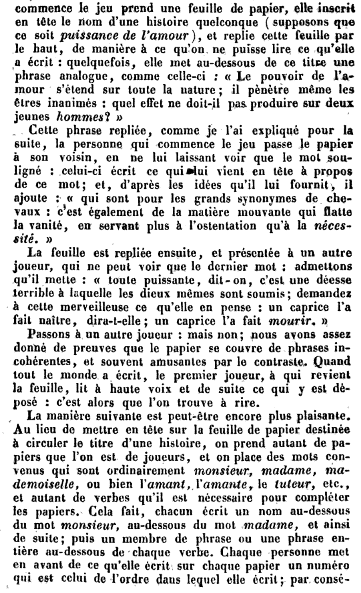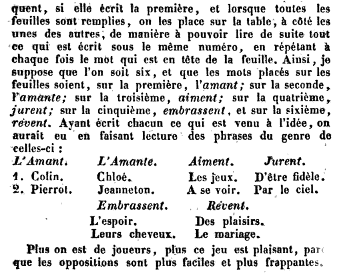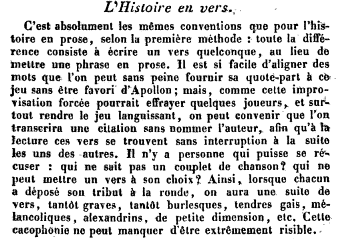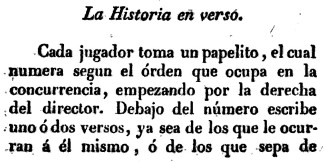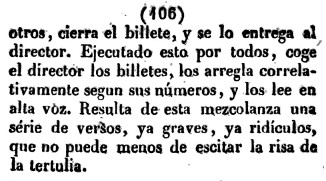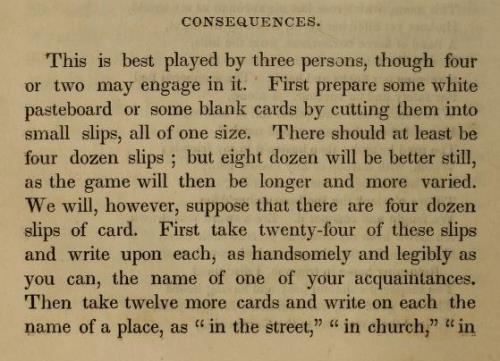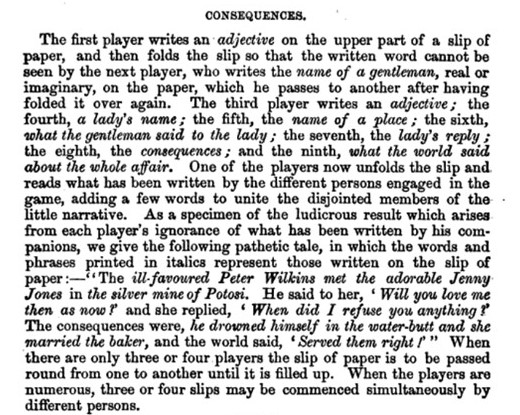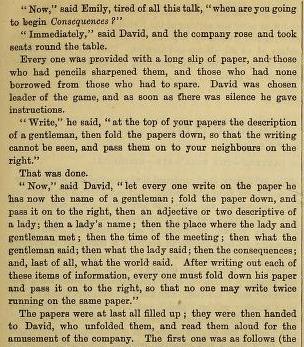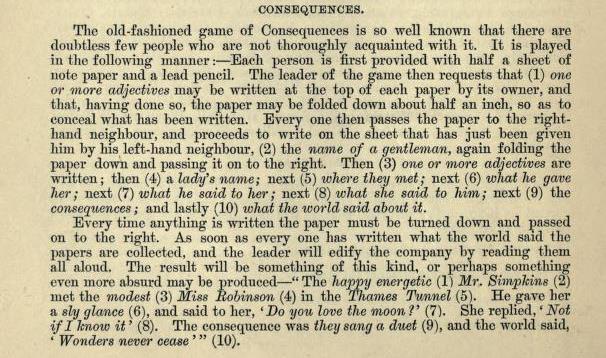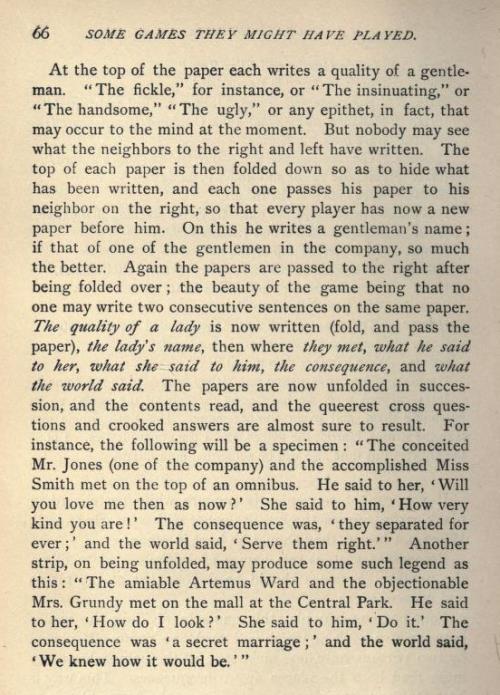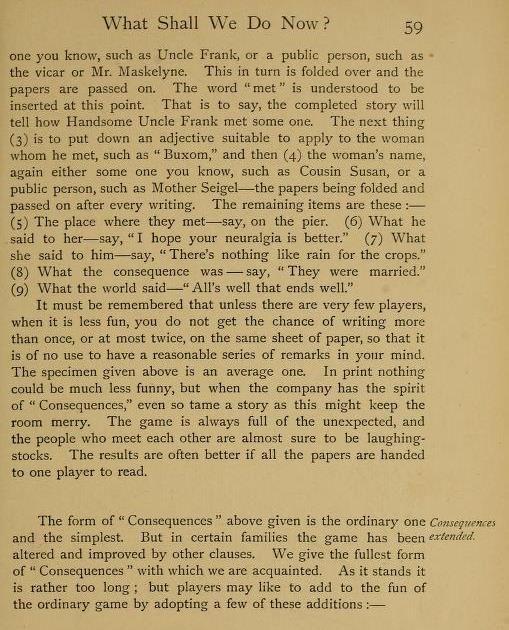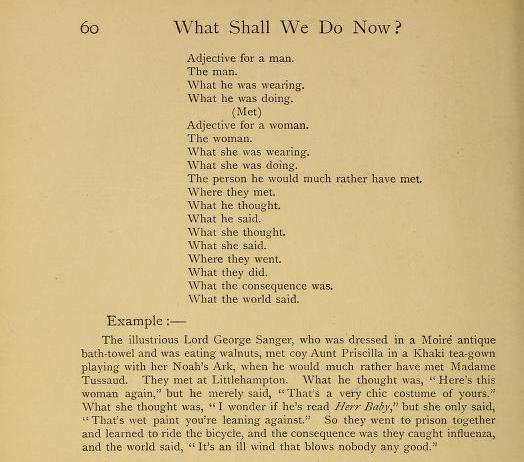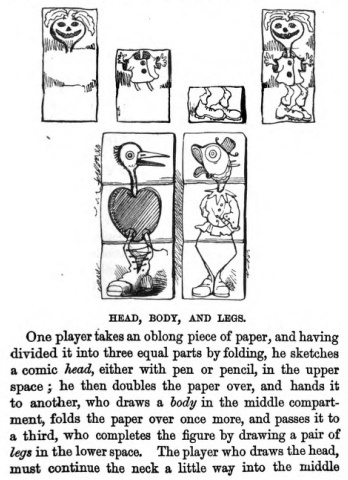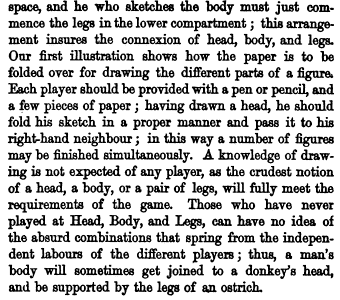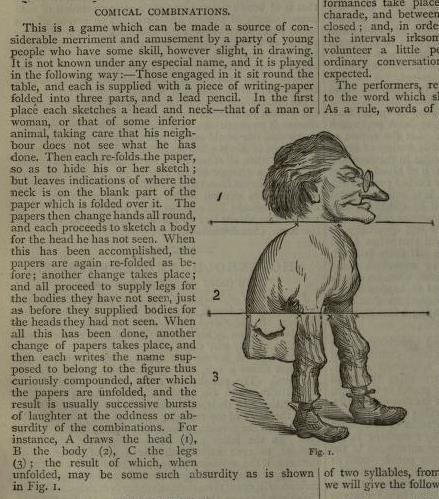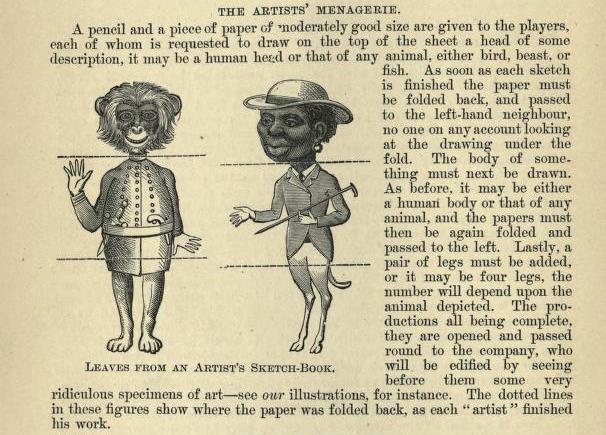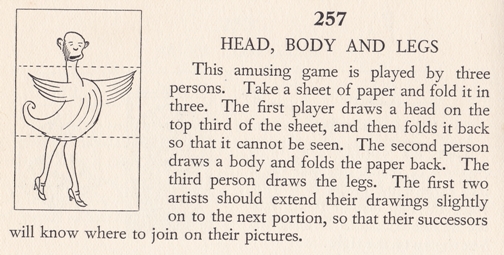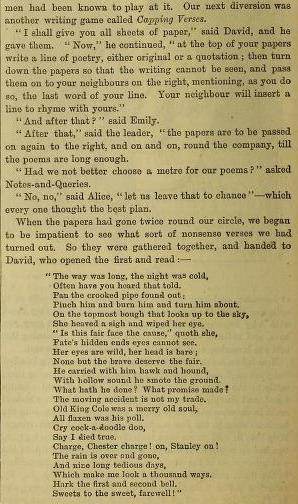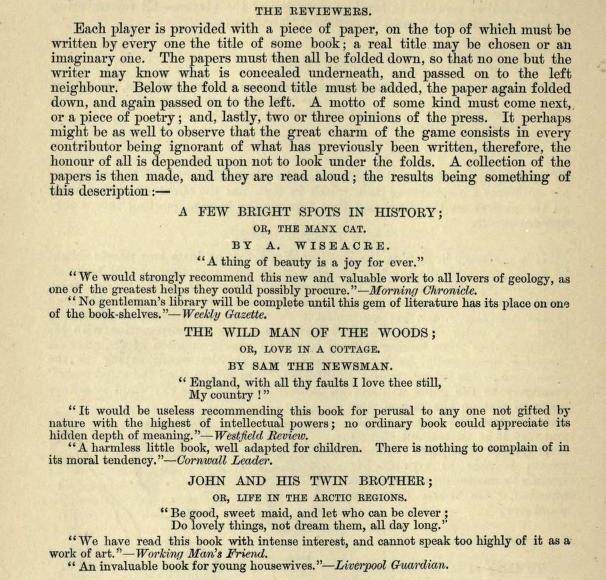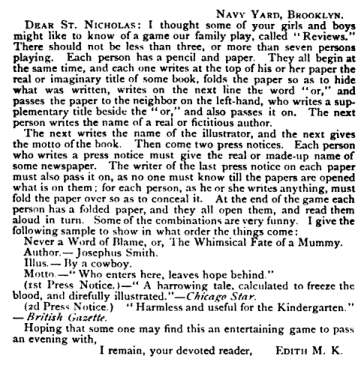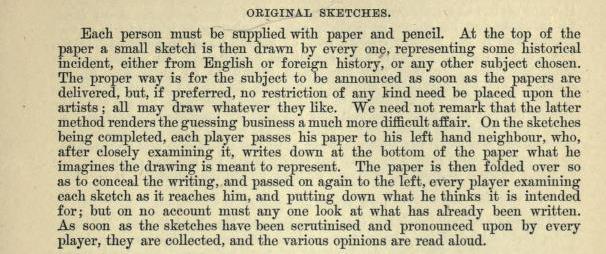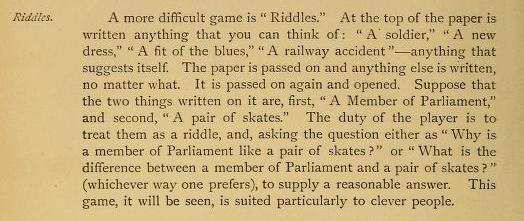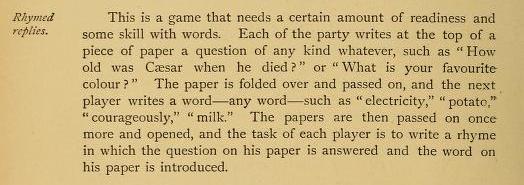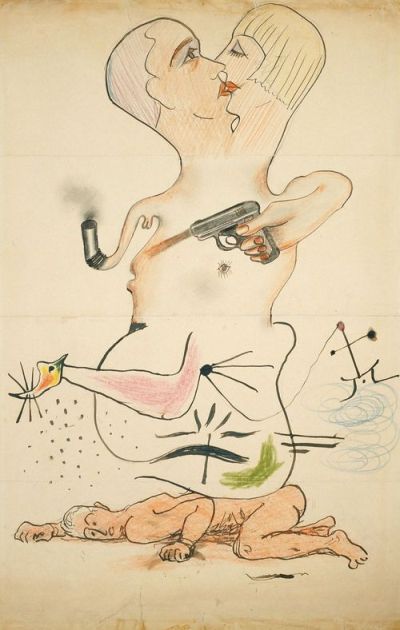| The Public Paperfolding History Project
Last updated 13/3/2023 x |
|||||||
| Write and Fold Games / Draw and Fold Games / Le Cadavre Exquis | |||||||
| This page is being used to
collect information about the history of Write and Fold
Games / Draw and Fold Games / Le Cadavre Exquis (also
known, in English, as the Exquisite Corpse). Please
contact me if you know any of this information is
incorrect or if you have any other information that
should be added. Thank you. ********** L'Histoire 1827 This game is described in in 'Manuel Complet des Jeux de Société' by Elisabeth Celnart, which was published by La Librairie Encyclopedique de Roret in Paris in 1827. Two different versions of the game are given, one which is more or less in an open format and in which each successive player only sees the last word of what was previously written, and one in which each player adds information according to a previously agreed set of categories. The opening sentence says, roughly, 'The game of 'l'histoire' is the same as the game of 'l'amphigouri', 'roman impromptu' and 'secretaire' of which we speak later'. However, it does not appear to me as though the other games make use of paperfolding in the same way as 'l'histoire' does. The instructions are not always clear on this point, however.
********** L'Histoire en vers 1827 This game is also described in in 'Manuel Complet des Jeux de Société' by Elisabeth Celnart, which was published by La Librairie Encyclopedique de Roret in Paris in 1827. It is the same as the game of L'histoire except that what is written on the paper needs to be in verse.
********** 1831 'Manual completo de juegos de sociedad o tertulia y la prendas', translated by Frances for D. Mariano de Rementería y Fica, which was published by Palacios in Madrid in 1831, contains a translation of the section about 'L'Histoire en vers' which appeared in Celnart (see above).
********** Consequences 1831 The earliest description of this well known game, in which part of a strongly structured story is written on a sheet of paper which is then folded to conceal the writing before being passed to another person who then writes another part of the story on the paper which is then folded to conceal it etc and so on until the story is complete, that I know of appears in the 'American Girl's Book or Occupation for Play Hours' by Eliza Leslie, which was published in Boston and New York in 1831.
********** 1859 A description of how to play Consequences also appears in 'Games and Sports for Young Boys', which was published by Routledge, Warne and Routledge in London and New York in 1859.
********** The game also appears: 1873 In 'The Popular Recreator', which was published by Cassell and Co in London in 1873.
********** 1881 In 'Cassell's Book of Indoor Amusements, Card Games and Fireside Fun', which was published by Cassell and Co in London in 1881.
********** 1883 In 'The American Girls's Home Book of Work and Play' by Helen Campbell, which was published by G P Putnam's Sons in 1883, contains two descriptions of how to play the game of Consequences, the first uses individually pieces of paper and card, the second a larger piece of paper which is folded as the game progresses.
********** In 'What Shall We Do Now?', by Edward Verral Lucas and Elizabeth Lucas, which was published in 1900.
********** Head, Body and Legs 1859 The game of Head, Body and Legs appears in 'Games and Sports for Young Boys', which was published by Routledge, Warne and Routledge in London and New York in 1859. In this game the paper is divided into three parts. One person draws a head on the top third, folds the paper so as to conceal what they have drawn, then passes it on to a second person who draws the body without knowing what the head looks like. A third person draws the legs in a similar way before the strange creature they have created is revealed.
********** This game also appeared: 1864 In 'Every Little Boy's Book', which was published by Routledge, Warne and Routledge in London and New York in 1864.
********** 1869 As 'Comical Combinations in 'Cassell's Household Guide: Volume 1' which was published in 1869.
********** 1881 As 'The Artist's Menagerie' in 'Cassell's Book of Indoor Amusements, Card Games and Fireside Fun', which was published by Cassell and Co in London in 1881.
********** 1933 In 'Diversions and Pastimes' by R M Abraham, which was first published by Constable and Constable in London in 1933.
********** Capping Verses 1873 A description of this game, which produces strange poetry rather than a story, appears in 'The Popular Recreator', which was published by Cassell and Co in London in 1873.
*********** 1881 This game also appeared in 'Cassell's Book of Indoor Amusements, Card Games and Fireside Fun', which was published by Cassell and Co in London in 1881.
********** Reviews 1881 This game appears as 'The Reviewers' in 'Cassell's Book of Indoor Amusements, Card Games and Fireside Fun', which was published by Cassell and Co in London in 1881.
********** 1887 This game was also described in a reader's letter, in the Letterbox column, of the April 1887 issue of the children's magazine St Nicholas.
********** Original Sketches 1881 This game appeared in 'Cassell's Book of Indoor Amusements, Card Games and Fireside Fun', which was published by Cassell and Co in London in 1881.
********** Other Games 1900 Two simple games involving folding paper appears in 'Großes illustriertes Spielbuch für Mädchen, by Jeanne Marie von Gayette-Georgens, which was published by Verlag von B. Serlet in Berlin in 1900. (Information from Juan Gimeno). In the first game a square of white paper is folded so that the four corners meet in the middle. A letter of the alphabet is written on the back. Under each flap a question is written, and on top an answer that relates to it, written by another person, all of which must begin with the letter of the alphabet written on the back. The folded sheets are then redistributed and the questions and answers read out loud in the form of a letter. (Information from Edwin Corrie)
*** The second game is to write a note on a rectangular sheet of paper and fold it into a triangular letter fold as shown by the lines in the drawing, which will seal it, then throw it into a 'post bag'. The notes are then taken out and addressed, put back into the bag, then taken out again and the addresses and contents read out loud. (Information from Edwin Corrie). Presumably to much hilarity.
********** Riddles 'What Shall We Do Now?', by Edward Verral Lucas and Elizabeth Lucas, which was published in 1900, contains another write and fold game titled 'Riddles'.
********** Rhymed replies 'What Shall We Do Now?', by Edward Verral Lucas and Elizabeth Lucas, which was published in 1900, contains another write and fold game titled 'Rhymed replies'.
********** Le Cadavre Exquis c1925 In his book 'Dada & Surrealist Art', Thames and Hudson, 1978, William S. Rubin writes, 'Among Surrealist techniques exploiting the mystique of accident was a kind of collective collage of words or images called the cadavre exquis (exquisite corpse). Based on an old parlor game, it was played by several people, each of whom would write a phrase on a sheet of paper, fold the paper to conceal part of it, and pass it on to the next player for his contribution.The technique got its name from results obtained in initial playing, "Le cadavre / exquis / boira / le vin / nouveau", and 'It was natural that such oracular truths should be similarly sought through images, and the game was immediately adapted to drawing, producing a series of hybrids the first reproductions of which are to be found in No. 9-10 of La Révolution surrealiste (October, 1927) without identification of their creators. The game was adapted to the possibilities of drawing, and even collage, by assigning a section of a body to each player, though the Surrealist principle of metaphoric displacement led to images that only vaguely resembled the human form.'
A collaborative Cadavre Exquis drawing by Man Ray, Yves Tanguy, Joan Miró and Max Morise, 1928. The creases where the paper was folded to conceal the previous parts of the drawing are clearly visible. Andre Breton, writing in the catalogue of an exhibition at La Dragonne, Galerie Nina Dausset, Paris, 7-30 October 1948, entitled "Le Cadavre Exquis: Son Exaltation" asserted that 'The Exquisite Corpse was born, if we remember correctly (and if that is the proper expression), around 1925 in the old house at 54 rue du Chateau, since destroyed.' and that '... we had no difficulty in agreeing that the Exquisite Corpse method did not visibly differ from that of 'consequences'. Surely nothing was easier than to transpose this method to drawing, by using the same system of folding and concealing.' and 'These drawings represent total negation of the ridiculous activity of imitation of physical characteristics, to which a large and most questionable part of contemporary art is still anachronistically subservient.' Wikipedia states 'but Pierre Reverdy wrote that it started much earlier, at least before 1918', but I have been unable to verify this reference. ********** |
|||||||

